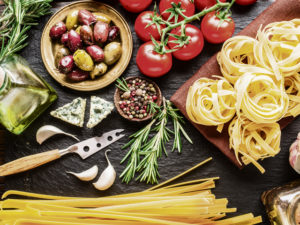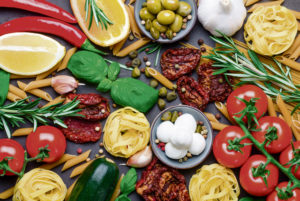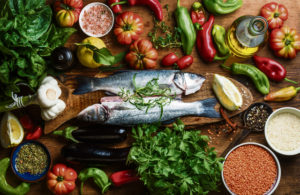The Mediterranean Diet (MD for short) is a nutritional recommendation based on foods inspired by traditional dietary patterns from the Mediterranean region of the world. This region consists of countries between Europe, northern Africa, and southwestern Asia along the Mediterranean Sea. As this organized nutrition is practiced by more and more people every day, it shouldn’t really be considered a diet but more like a lifestyle.
What is a Mediterranean Diet?
Mediterranean Diet is a selection of foods based on the Mediterranean Diet Food Pyramid. MD requires a high consumption of carbohydrates, fish, olive oil, legumes, whole grains and vegetables; a moderate consumption of dairy products; and a low consumption of meat products. Additionally, it requires foods to be organically grown with no genetically modified organisms (GMO) and treated with chemicals as little as possible.
Carbohydrates
The main source of energy in MD foods is carbohydrates but not just any kind. Grains are consumed in the form of whole grain bread, whole grain pasta, whole grain couscous, etc. Whole grain is a great source of complex carbohydrates and it has a low Glycemic Index (GI). These carbs provide energy for a longer period of time and don’t raise blood sugar levels (at least not much). This means they don’t provoke insulin spikes. Also, whole grain carbs are rich in vitamins (especially B vitamins), minerals (magnesium & potassium), and fibers. This food group is especially important for feeling full and satiated while enhancing a healthy digestive system.

Starchy vegetables (like potatoes) are also a great source of carbohydrates, especially for people who are physically active. Due to their potassium content, they are very important during periods of extensive sweating. On the other hand, people who are not physically active should limit their intake of starchy vegetables as well as grains.
Other great sources of complex carbohydrates are beans, peas, and other legumes. These vegetables provide vitamins and minerals as well as serving as an excellent source of digestive fibers. Again, people who are not physically active should limit their legumes intake to keep their carbohydrate intake to desired levels.
Green and leafy vegetables
Green and leafy vegetables are consumed as often as possible as they are a rich source of vitamins, minerals and antioxidants. They have low amounts of complex carbs and are digested very slowly due to their fiber content. Additionally, these veggies require the body to burn more energy during digesting than after digestion. In other words, they literally burn fat. Some examples of green and leafy vegetables are kale, cauliflower, spinach, broccoli, tomatoes, lettuce, zucchini, cucumbers and more.
Packing with protein
The main sources of protein in MD are fish, cottage cheese, low-fat cheese, milk, organic and/or omega-3 eggs, poultry and red meat. Fish is consumed sometimes even a few times per day in moderate amounts (200 – 300g per serving). Though it is most healthy to consume fresh fish, it is also okay to eat it salted or smoked or even canned.
It is important to note that most MD fish are seasonal species such as sardines, anchovies, Atlantic mackerel, and similar. These are the best choices of fish because they are low in mercury, cadmium and other pollutants. While tuna and marlins are often considered delicacies, they should not be eaten too often due to their high concentrations of mercury and other toxins.

Eggs are consumed daily, but rarely more than one or two eggs per day. Organic and omega-3 eggs have an excellent high-density lipoprotein (good cholesterol) and low-density lipoprotein (bad cholesterol) ratio and are high in vitamin A and iron. However, due to their fat content (two medium-sized eggs have 12-15g of fats), their daily amount should be limited.
Poultry is a great lean protein and it is consumed once or twice per week. Although red meat is also a good source of protein, it should be consumed only several times a month due to being rich in saturated fats. When cooking red meat, it is a great idea to add lemon juice, garlic, parsley, and similar herbs and spices to enhance the flavor. The health benefit of adding lemon juice is that it increases iron absorption.
Balancing your fat intake
In order to function properly, the human body requires approximately one-third of saturated fats, one-third of monounsaturated fats and one-third of polyunsaturated fats. In western nutrition, unsaturated fats intake is too low, which can lead to many health issues including high cholesterol levels, diabetes, heart issues, and other diseases. Fats in MD are very balanced and come mostly from sources like olive oil, fish oil, fatty fish, nuts, organic eggs, butter (from cattle that graze grass and small bushes), whole fat milk (from cows, sheep, goats, etc.), cheese and similar items.
Olive oil is full of omega-6 and omega-9 and other healthy unsaturated fats, but it (including extra virgin oil) does not contain omega-3. When preparing fish with olive oil and adding lemon juice; garlic; parsley and some green or leafy vegetables, it becomes a delicacy rich in omega-3, omega-6, and omega-9.
Fatty fish are rich in fat-soluble vitamins like vitamin D and E. Vitamin A is often present in the liver of various fish species in such a great amount that it may cause vitamin A poisoning. Therefore, care must be taken when consuming fish liver.

Dairy products
Cottage cheese and low-fat cheese are consumed on a daily basis and they both are full of calcium. When cheese is combined with fatty fish (vitamin D), the calcium absorption is increased. When consumed on a regular basis, this helps in avoiding or postponing issues like osteoporosis (a progressive bone disease) and osteomalacia (softening of bones). It also fights against rickets in children.
MD suggests whole fat milk from grass grazing animals like goats, sheep, and cows are to be consumed. Unfortunately, lactose-intolerant people should avoid milk due to the adverse reaction which may cause abdominal bloating, cramps, flatulence, diarrhea, nausea, and vomiting. Also, people should avoid consuming milk that is rich in iron due to its tendency to block or at least hinder iron absorption.
Fruit intake
Fruits contain solid amounts of simple to medium complex carbohydrates as well as they are a wonderful source of vitamins, minerals, antioxidants, and fibers. They should be consumed mostly fresh, but dried or processed in various ways are okay too. When on a diet, one should limit fruit intake but should not entirely be avoided. Fruits of the Mediterranean Diet are oranges, tangerines, figs, cherries, various berries, apricots, apples, and more.
What to do when craving sweets
Sweets are eaten rarely, once or twice a month, on the Mediterranean Diet. If you do have cravings for sweets and you need some kind of dessert, fruits or a fruit combination is the solution. A fruit salad made out of wild strawberries, blackberries, and nectarine with a slice or two of oranges and few drops of lemon is more than enough to satisfy your taste buds. Not to mention, they are just bursting with vitamins, minerals, and other healthy nutrients.
The downside

The Mediterranean Diet is obviously a great diet for life, but one must be aware of its drawbacks. The first drawback is the mercury levels in fish. The US FDA (Food and Drug Administration) and NRDC (Natural Resources Defense Council) regularly update the amount of mercury and other pollutants in foods (including in fish). For example, the FDA’s report from 1990-2010 stated that the average level of mercury in swordfish was 0.995 parts per million (ppm) (3.220 ppm maximum) and in sardines was 0.013 ppm (0.083 ppm maximum). In comparison, seven ounces of swordfish had the same amount of mercury level as 529 ounces of sardines. I don’t know about you, but I like sardines more and more every day.
MD’s second drawback is the relatively high intake of carbohydrates coming from grains, legumes, and potatoes. It is important to limit your carbohydrate intake especially if you are not very physically active. Weight gain comes from a calorie surplus (even from a balanced nutrition like MD) and very little or no physical activity. Therefore, it is best to monitor your weight once a week and decrease or increase your carb intake accordingly.
The long story short about the Mediterranean Diet
Mediterranean Diet is a balanced diet, plain and simple. It provides the body with needed nutrients in abundance. If one needs to lose weight, simple portion control of certain foods can decrease daily calorie intake. On the other hand, there are no fast foods and similar ‘cheat meals’ when doing the Mediterranean Diet. If you have an urge to cheat, do it for sanity’s sake. However, don’t do it often (once a month is acceptable), and be sure to continue with your diet right after cheating. MD offers so many opportunities for making delicious meals with limited amount of calories. Many people find that being on the Mediterranean Diet for a long period of time is not a problem at all.
Author Profile: Patrick Mayer is a strength coach and sport nutritionist specialized in training and nutrition for both beginners and advanced trainees. For staying fit and healthy, he highly recommends physical activity with or without exercise equipment, proper nutrition and enough sleep and rests. Patrick Mayer is one of the leading authors on Staying Fit.


